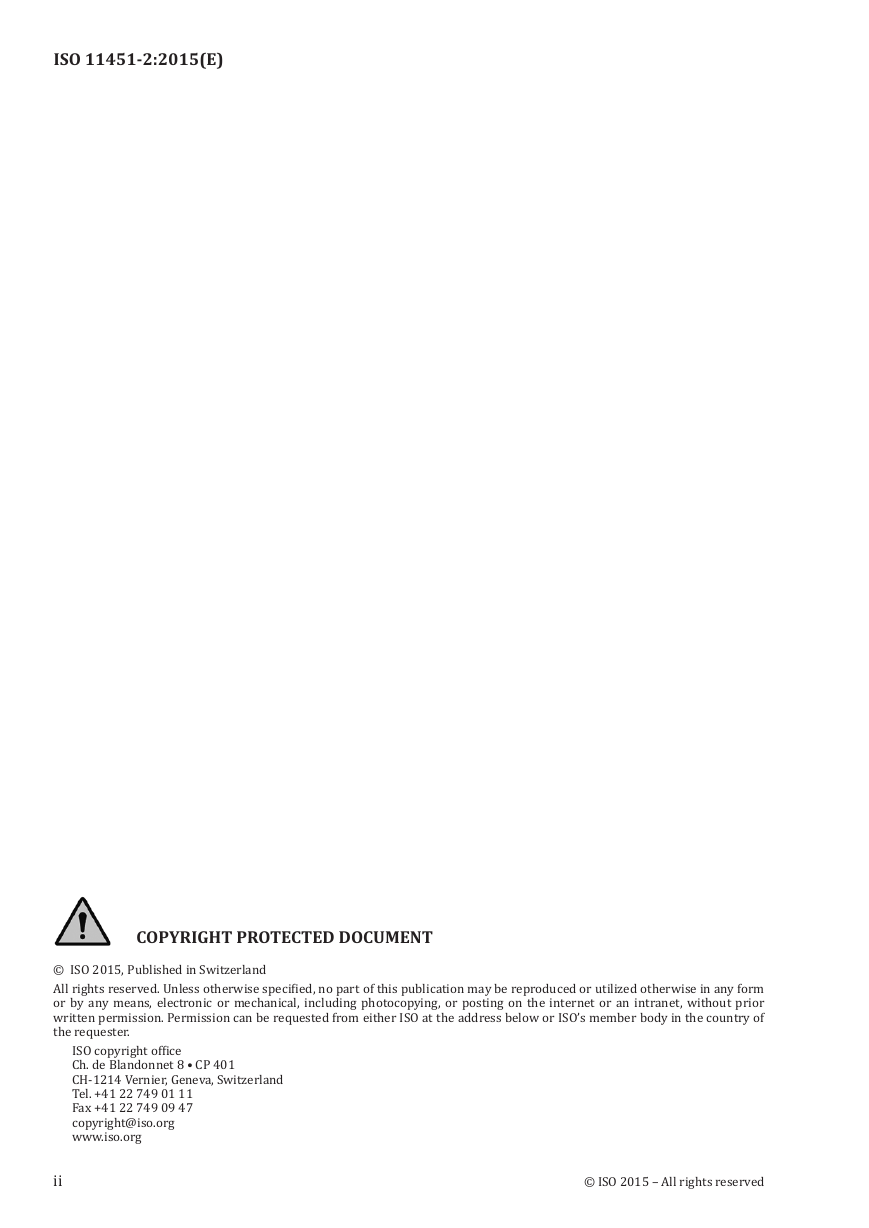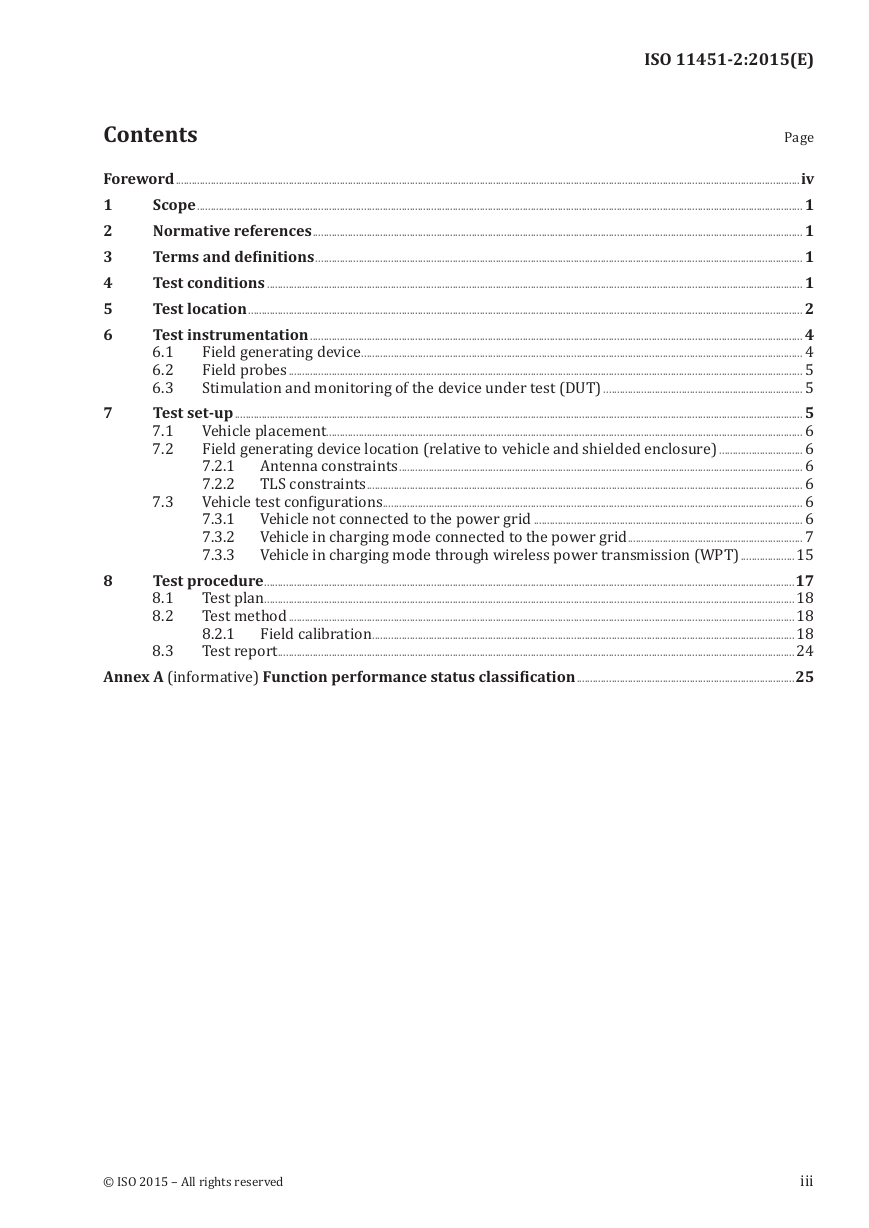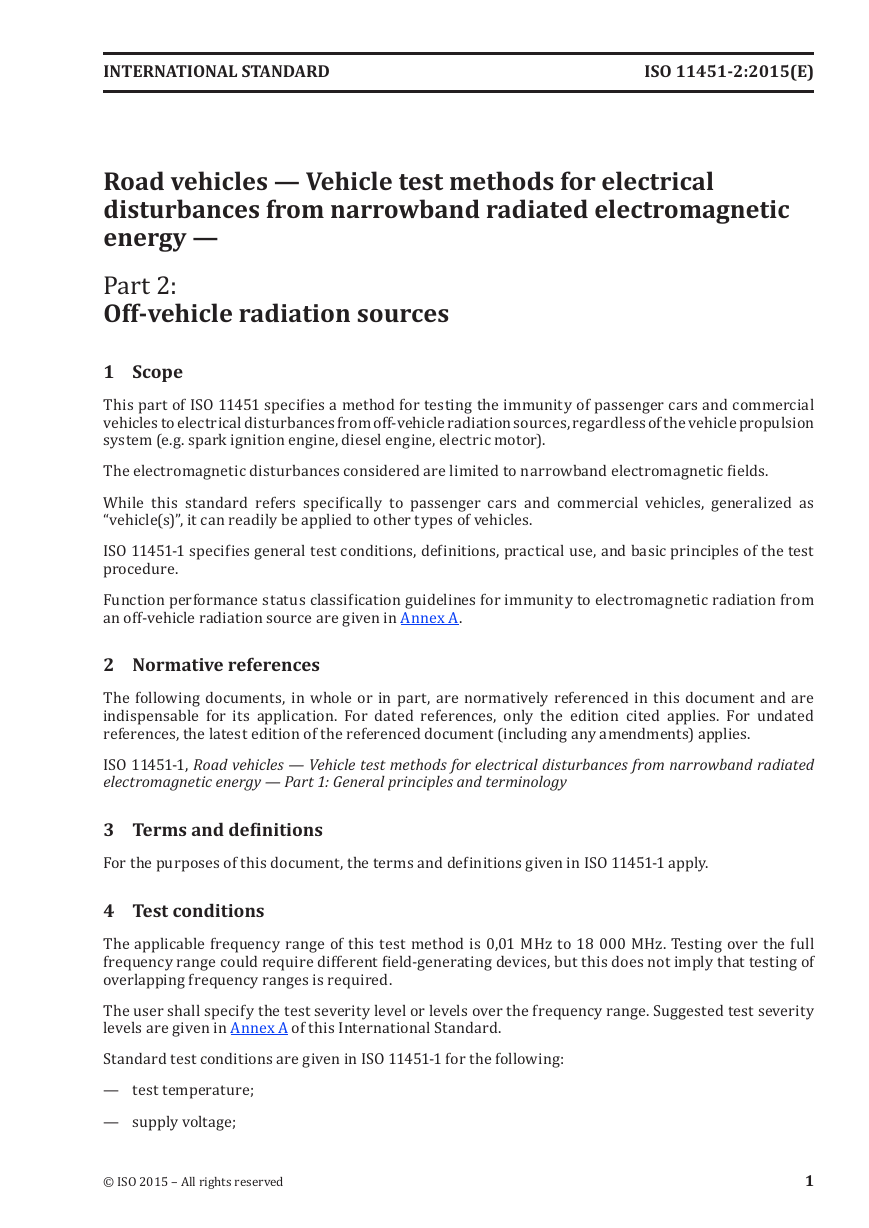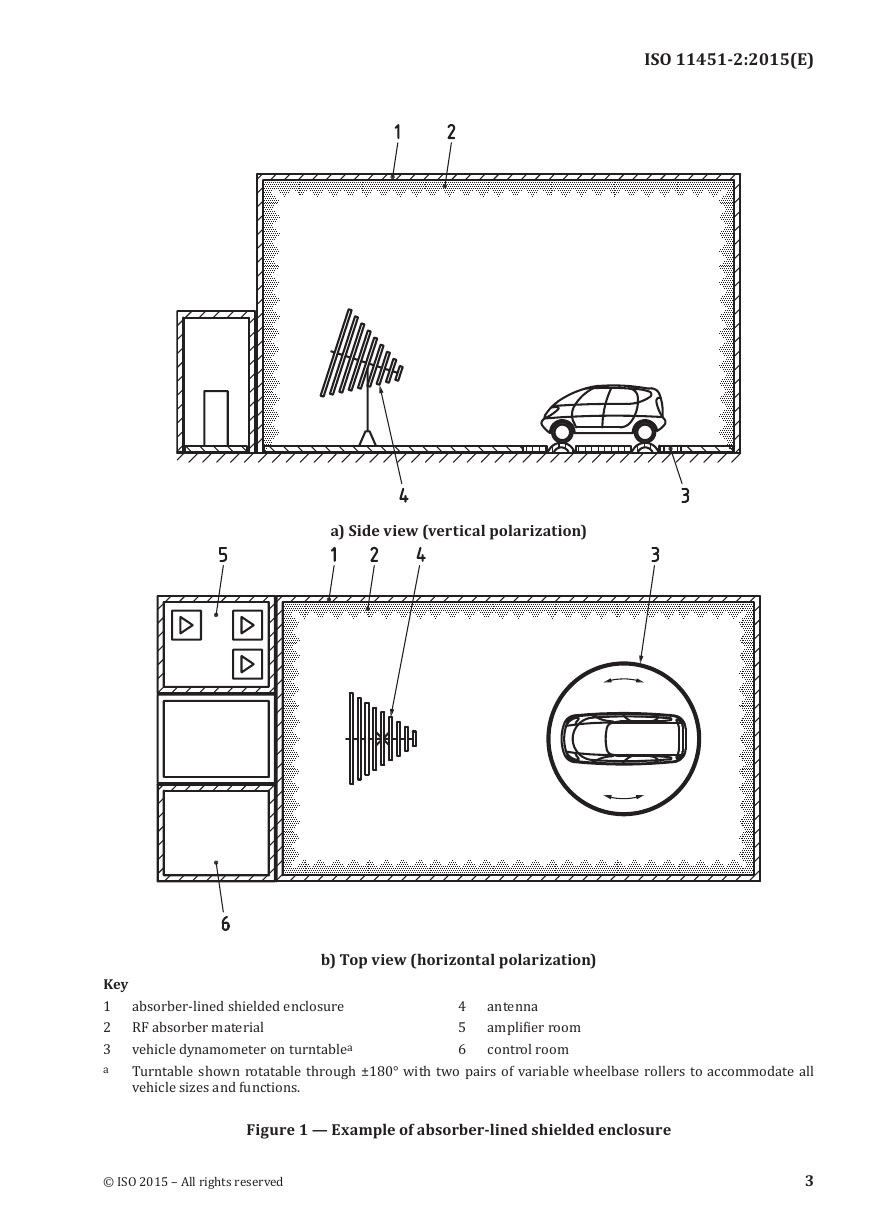INTERNATIONAL
STANDARD
ISO
11451-2
Fourth edition
2015-06-01
Road vehicles — Vehicle test methods
for electrical disturbances from
narrowband radiated electromagnetic
energy —
Part 2:
Off-vehicle radiation sources
Véhicules routiers — Méthodes d’essai d’un véhicule soumis
à des perturbations électriques par rayonnement d’énergie
électromagnétique en bande étroite —
Partie 2: Sources de rayonnement hors du véhicule
Reference number
ISO 11451-2:2015(E)
© ISO 2015
�
ISO 11451-2:2015(E)
COPYRIGHT PROTECTED DOCUMENT
© ISO 2015, Published in Switzerland
All rights reserved. Unless otherwise specified, no part of this publication may be reproduced or utilized otherwise in any form
or by any means, electronic or mechanical, including photocopying, or posting on the internet or an intranet, without prior
written permission. Permission can be requested from either ISO at the address below or ISO’s member body in the country of
the requester.
ISO copyright office
Ch. de Blandonnet 8 • CP 401
CH-1214 Vernier, Geneva, Switzerland
Tel. +41 22 749 01 11
Fax +41 22 749 09 47
copyright@iso.org
www.iso.org
ii
© ISO 2015 – All rights reserved
�
ISO 11451-2:2015(E)
1
2
3
4
5
6
7
Contents
Page
Foreword ........................................................................................................................................................................................................................................iv
Scope .................................................................................................................................................................................................................................1
Normative references ......................................................................................................................................................................................1
Terms and definitions .....................................................................................................................................................................................1
Test conditions .......................................................................................................................................................................................................1
Test location ..............................................................................................................................................................................................................2
Test instrumentation .......................................................................................................................................................................................4
6.1
Field generating device ....................................................................................................................................................................4
6.2
Field probes ...............................................................................................................................................................................................5
Stimulation and monitoring of the device under test (DUT) ..........................................................................5
6.3
Test set-up ...................................................................................................................................................................................................................5
7.1
Vehicle placement .................................................................................................................................................................................6
7.2
Field generating device location (relative to vehicle and shielded enclosure) ...............................6
Antenna constraints ......................................................................................................................................................6
7.2.1
7.2.2
TLS constraints ..................................................................................................................................................................6
7.3
Vehicle test configurations ............................................................................................................................................................6
7.3.1
Vehicle not connected to the power grid ....................................................................................................6
Vehicle in charging mode connected to the power grid .................................................................7
7.3.2
7.3.3
Vehicle in charging mode through wireless power transmission (WPT) ....................15
Test procedure .....................................................................................................................................................................................................17
Test plan .....................................................................................................................................................................................................18
8.1
Test method ............................................................................................................................................................................................18
8.2
8.2.1
Field calibration .............................................................................................................................................................18
Test report ................................................................................................................................................................................................24
8.3
Annex A (informative) Function performance status classification .................................................................................25
8
© ISO 2015 – All rights reserved
iii
�
ISO 11451-2:2015(E)
Foreword
ISO (the International Organization for Standardization) is a worldwide federation of national standards
bodies (ISO member bodies). The work of preparing International Standards is normally carried out
through ISO technical committees. Each member body interested in a subject for which a technical
committee has been established has the right to be represented on that committee. International
organizations, governmental and non-governmental, in liaison with ISO, also take part in the work.
ISO collaborates closely with the International Electrotechnical Commission (IEC) on all matters of
electrotechnical standardization.
The procedures used to develop this document and those intended for its further maintenance are
described in the ISO/IEC Directives, Part 1. In particular the different approval criteria needed for the
different types of ISO documents should be noted. This document was drafted in accordance with the
editorial rules of the ISO/IEC Directives, Part 2 (see www.iso.org/directives).
Attention is drawn to the possibility that some of the elements of this document may be the subject of
patent rights. ISO shall not be held responsible for identifying any or all such patent rights. Details of
any patent rights identified during the development of the document will be in the Introduction and/or
on the ISO list of patent declarations received (see www.iso.org/patents).
Any trade name used in this document is information given for the convenience of users and does not
constitute an endorsement.
For an explanation on the meaning of ISO specific terms and expressions related to conformity
assessment, as well as information about ISO’s adherence to the WTO principles in the Technical Barriers
to Trade (TBT) see the following URL: Foreword - Supplementary information
The committee responsible for this document is ISO/TC 22, Road vehicles, Subcommittee SC 32, Electrical
and electronic components and general system aspects.
Annex A of this part of ISO 11451 is for information only.
This fourth edition cancels and replaces the third edition (ISO 11451-2:2005) which has been technically
revised.
ISO 11451 consists of the following parts, under the general title Road vehicles — Vehicle test methods for
electrical disturbances from narrowband radiated electromagnetic energy:
— Part 1: General principles and terminology
— Part 2: Off-vehicle radiation sources
— Part 3: On-board transmitter simulation
— Part 4: Bulk current injection (BCI)
iv
© ISO 2015 – All rights reserved
�
INTERNATIONAL STANDARD
ISO 11451-2:2015(E)
1 Scope
2 Normative references
3 Terms and definitions
4 Test conditions
Off-vehicle radiation sources
Road vehicles — Vehicle test methods for electrical
disturbances from narrowband radiated electromagnetic
energy —
Part 2:
This part of ISO 11451 specifies a method for testing the immunity of passenger cars and commercial
vehicles to electrical disturbances from off-vehicle radiation sources, regardless of the vehicle propulsion
system (e.g. spark ignition engine, diesel engine, electric motor).
The electromagnetic disturbances considered are limited to narrowband electromagnetic fields.
While this standard refers specifically to passenger cars and commercial vehicles, generalized as
“vehicle(s)”, it can readily be applied to other types of vehicles.
ISO 11451-1 specifies general test conditions, definitions, practical use, and basic principles of the test
procedure.
Function performance status classification guidelines for immunity to electromagnetic radiation from
an off-vehicle radiation source are given in Annex A.
The following documents, in whole or in part, are normatively referenced in this document and are
indispensable for its application. For dated references, only the edition cited applies. For undated
references, the latest edition of the referenced document (including any amendments) applies.
ISO 11451-1, Road vehicles — Vehicle test methods for electrical disturbances from narrowband radiated
For the purposes of this document, the terms and definitions given in ISO 11451-1 apply.
The applicable frequency range of this test method is 0,01 MHz to 18 000 MHz. Testing over the full
frequency range could require different field-generating devices, but this does not imply that testing of
overlapping frequency ranges is required.
The user shall specify the test severity level or levels over the frequency range. Suggested test severity
levels are given in Annex A of this International Standard.
Standard test conditions are given in ISO 11451-1 for the following:
— test temperature;
— supply voltage;
© ISO 2015 – All rights reserved
electromagnetic energy — Part 1: General principles and terminology
1
�
ISO 11451-2:2015(E)
5 Test location
— modulation;
— dwell time;
—
frequency step sizes;
— definition of test severity levels;
— test signal quality.
The test should be performed in an absorber-lined shielded enclosure.
The aim of using an absorber-lined shielded enclosure is to create an indoor electromagnetic compatibility
testing facility that simulates open field testing.
The size, shape, and construction of the enclosure can vary considerably. Typically, the floor is not
covered with absorbing material, but such covering is allowed. Measurements in enclosures with or
without floor absorbers can lead to different results. The minimum size of the shielded enclosure is
determined by the size of the test region needed, the size of the field generation device or devices, the
needed clearances between these and the largest vehicle to be tested, and the characteristics of the
absorbing material. To create the test region, the absorber, field generation system and enclosure shape
are selected such that the amount of extraneous energy in the test region is reduced to below a minimum
value that will give the desired measurement accuracy. The design objective is to reduce the reflected
energy in the test region to −10 dB or less over the test frequency range (not applicable to transmission
line system (TLS) field generation systems). An example of a rectangular shielded enclosure is shown
in Figure 1.
The test may alternatively be performed at an outdoor test site. The test facility shall comply with
(national) legal requirements regarding the emission of electromagnetic fields.
2
© ISO 2015 – All rights reserved
�
ISO 11451-2:2015(E)
a) Side view (vertical polarization)
Key1
2
3
a
antenna
amplifier room
control room
absorber-lined shielded enclosure
RF absorber material
vehicle dynamometer on turntablea
Turntable shown rotatable through ±180° with two pairs of variable wheelbase rollers to accommodate all
vehicle sizes and functions.
© ISO 2015 – All rights reserved
Figure 1 — Example of absorber-lined shielded enclosure
b) Top view (horizontal polarization)
4
5
6
3
�
ISO 11451-2:2015(E)
6 Test instrumentation
Testing consists of generating radiated electromagnetic fields using antenna sets with radio frequency
(RF) sources capable of producing the desired field strength over the range of test frequencies.
The following test instrumentation is used:
— Field generating device(s): e.g. antenna(s);
— Field probe(s);
— RF signal generator with internal or external modulation capability;
— High power amplifier(s);
— Powermeter (or equivalent measuring instrument) to measure forward power and reflected power.
The field generating device can be an antenna or a TLS.
The construction and orientation of any field generating device shall be such that the generated field
can be polarized in the mode specified in the test plan (see 8.1). An example of a parallel-plate TLS is
shown in Figure 2. Multiple antennas, amplifiers and directional couplers could be necessary to cover
the complete frequency range.
6.1 Field generating device
a) Side view
4
© ISO 2015 – All rights reserved
�
















 2023年江西萍乡中考道德与法治真题及答案.doc
2023年江西萍乡中考道德与法治真题及答案.doc 2012年重庆南川中考生物真题及答案.doc
2012年重庆南川中考生物真题及答案.doc 2013年江西师范大学地理学综合及文艺理论基础考研真题.doc
2013年江西师范大学地理学综合及文艺理论基础考研真题.doc 2020年四川甘孜小升初语文真题及答案I卷.doc
2020年四川甘孜小升初语文真题及答案I卷.doc 2020年注册岩土工程师专业基础考试真题及答案.doc
2020年注册岩土工程师专业基础考试真题及答案.doc 2023-2024学年福建省厦门市九年级上学期数学月考试题及答案.doc
2023-2024学年福建省厦门市九年级上学期数学月考试题及答案.doc 2021-2022学年辽宁省沈阳市大东区九年级上学期语文期末试题及答案.doc
2021-2022学年辽宁省沈阳市大东区九年级上学期语文期末试题及答案.doc 2022-2023学年北京东城区初三第一学期物理期末试卷及答案.doc
2022-2023学年北京东城区初三第一学期物理期末试卷及答案.doc 2018上半年江西教师资格初中地理学科知识与教学能力真题及答案.doc
2018上半年江西教师资格初中地理学科知识与教学能力真题及答案.doc 2012年河北国家公务员申论考试真题及答案-省级.doc
2012年河北国家公务员申论考试真题及答案-省级.doc 2020-2021学年江苏省扬州市江都区邵樊片九年级上学期数学第一次质量检测试题及答案.doc
2020-2021学年江苏省扬州市江都区邵樊片九年级上学期数学第一次质量检测试题及答案.doc 2022下半年黑龙江教师资格证中学综合素质真题及答案.doc
2022下半年黑龙江教师资格证中学综合素质真题及答案.doc